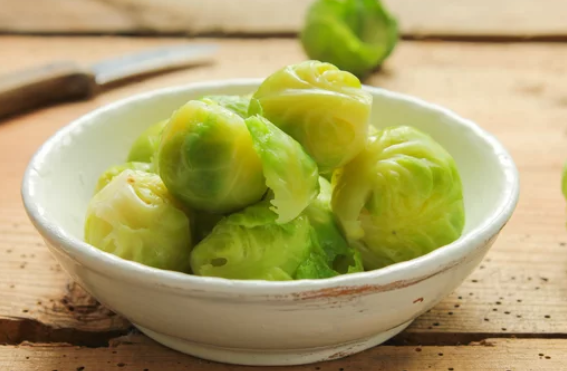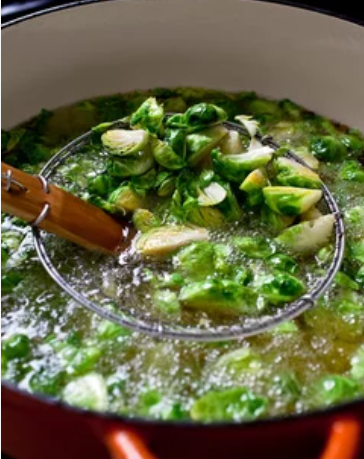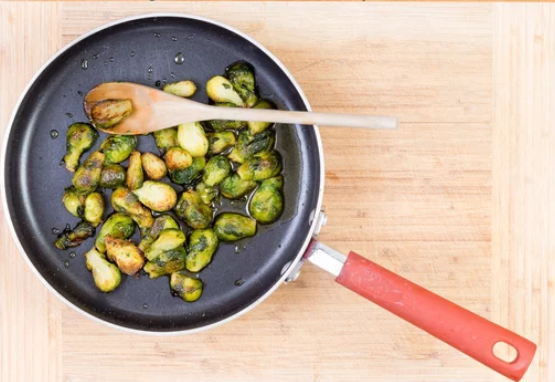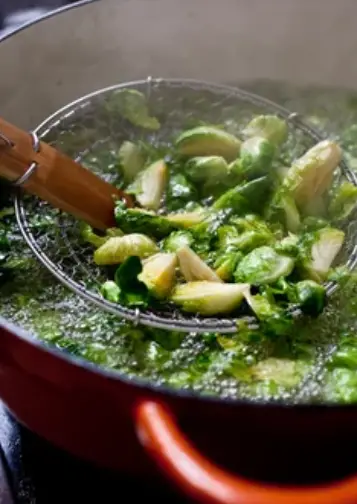If you’re looking to prepare Brussels sprouts for a dish, blanching them is a popular cooking method.
Blanching involves briefly boiling the Brussels sprouts in water before immediately cooling them in ice water to stop the cooking process.
This technique is often used to preserve the bright green color of the Brussels sprouts, as well as to help them cook evenly.
But how long should you blanch Brussels sprouts for?
In this blog post, we’ll explore the answer to that question and give you some tips on how to get the best results.
What is Brussels Sprouts?

Brussels sprouts are a type of leafy green vegetable that belongs to the Brassica family, which also includes other nutritious vegetables like broccoli, kale, and cabbage.
They are small, round vegetables that resemble mini cabbages and are typically green in color.
Brussels sprouts are native to Brussels, Belgium, and have been cultivated in Europe for hundreds of years.
They are now grown and enjoyed all over the world due to their delicious flavor and numerous health benefits.
Brussels sprouts are an excellent source of fiber, vitamins, minerals, and antioxidants, making them a nutritious addition to any diet.
Why Blanch Brussels Sprouts?

How Long Do You Blanch Brussel Sprouts
Before we dive into the specifics of blanching, let’s first discuss why you might want to use this cooking method. Blanching has several benefits when it comes to cooking Brussels sprouts:
- Preserves color: When you blanch Brussels sprouts, you briefly expose them to high heat, which helps to set the bright green color of the vegetable. This makes them more visually appealing in dishes.
- Softens texture: Blanching also helps to soften the texture of Brussels sprouts, which can be quite tough when they’re raw. This makes them more enjoyable to eat.
- Shortens cooking time: Finally, blanching can shorten the overall cooking time for Brussels sprouts. By partially cooking them in boiling water, you reduce the amount of time they need to spend in the oven or on the stove.
How Long to Blanch Brussels Sprouts

Small Brussels sprouts will only need to be blanched for about 3-4 minutes, while larger ones may need up to 6-7 minutes.
You should aim to blanch them just long enough to soften them slightly, without making them mushy.
To determine if your Brussels sprouts are ready to be removed from the boiling water, you can test them with a fork or a toothpick.
If they’re soft enough to be pierced easily, but still hold their shape, they’re ready to be cooled in ice water.
Tips for Blanching Brussels Sprouts
Now that you know how long to blanch Brussels sprouts for, let’s go over some tips to help you get the best results:
- Use plenty of water: When blanching Brussels sprouts, it’s important to use plenty of water to ensure that they cook evenly. You should use at least 4-5 quarts of water for every pound of Brussels sprouts.
- Salt the water: Adding salt to the boiling water can help to enhance the flavor of the Brussels sprouts. Aim for about 1 tablespoon of salt per gallon of water.
- Don’t overcrowd the pot: When blanching Brussels sprouts, you should avoid overcrowding the pot. If there are too many Brussels sprouts in the pot at once, they may not cook evenly.
- Cool them quickly: To stop the cooking process and preserve the color of the Brussels sprouts, it’s important to cool them in ice water immediately after blanching. This will also help to retain their nutrients and prevent them from becoming overcooked.
- Dry them thoroughly: After blanching and cooling, be sure to dry your Brussels sprouts thoroughly with a clean towel or paper towels. This will help to remove excess water and prevent them from becoming soggy.
Different Ways to Use Blanched Brussels Sprouts
Once you have blanched your Brussels sprouts, you can use them in a variety of dishes. Here are some ideas to get you started:
- Roasted Brussels Sprouts: After blanching, toss the Brussels sprouts in some olive oil and seasonings of your choice, then roast them in the oven until they’re crispy and caramelized.
- Brussels Sprouts Salad: Slice blanched Brussels sprouts thinly and toss them with a tangy vinaigrette and other salad ingredients, like chopped nuts and dried fruit.
- Stir-Fry: Blanching Brussels sprouts can also make them a great addition to stir-fry dishes. Simply stir-fry them with your other favorite vegetables and a protein of your choice.
- Pasta Dishes: Blanch Brussels sprouts and add them to your favorite pasta dishes for an extra pop of color and nutrition.
Nutritional Benefits of Brussels Sprouts
Brussels sprouts are not only delicious, but they’re also packed with nutrients. Here are some of the nutritional benefits of Brussels sprouts:
- Low in calories: One cup of Brussels sprouts contains only 56 calories.
- High in fiber: One cup of Brussels sprouts contains 4 grams of fiber, which can help to promote digestive health.
- Rich in vitamins: Brussels sprouts are an excellent source of vitamin C, vitamin K, and vitamin A.
- High in antioxidants: Brussels sprouts contain antioxidants like kaempferol and quercetin, which may help to reduce inflammation and lower the risk of chronic disease.
Conclusion
Brussels sprouts can be easily and effectively prepared for a number of meals by blanching them.
Following the advice in this blog post, you can ensure that your Brussels sprouts are delicious and aesthetically pleasing by blanching them for the recommended period of time.
You may enjoy the many health advantages of Brussels sprouts in a variety of ways, from roasted side dishes to ingredients in stir-fries.
Don’t be afraid to get creative with how you utilize them.
Reference
- U.S. Department of Agriculture. (2021). Brussels sprouts, raw. Retrieved from https://fdc.nal.usda.gov/fdc-app.html#/food-details/169267/nutrients
- Harvard T.H. Chan School of Public Health. (2020). Brussels sprouts. Retrieved from https://www.hsph.harvard.edu/nutritionsource/food-features/brussels-sprouts/
- Oregon State University. (2019). Brussels sprouts. Retrieved from https://lpi.oregonstate.edu/mic/food-beverages/brussels-sprouts
- The Spruce Eats. (2021). How to Blanch Brussels Sprouts. Retrieved from https://www.thespruceeats.com/how-to-blanch-brussels-sprouts-2215830




